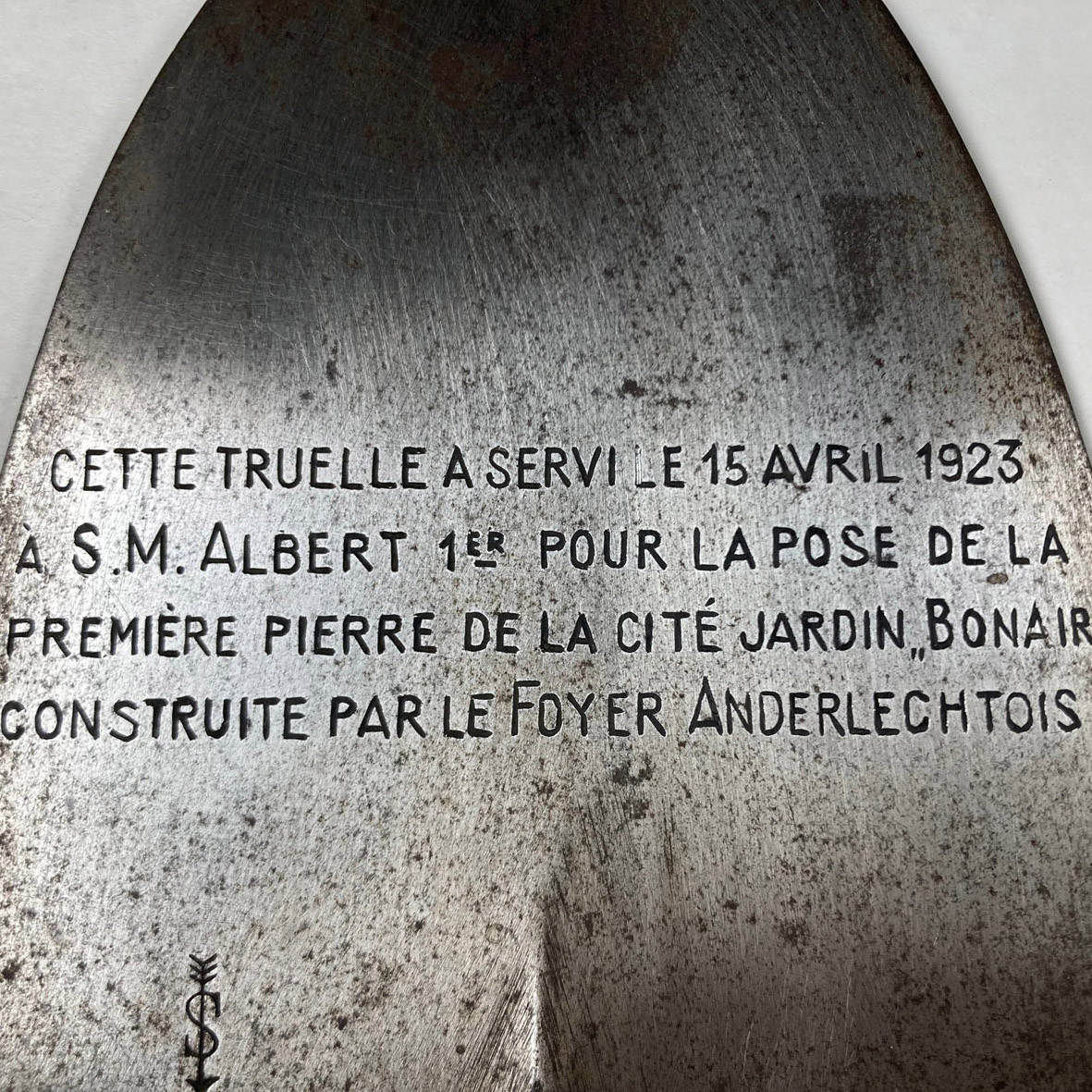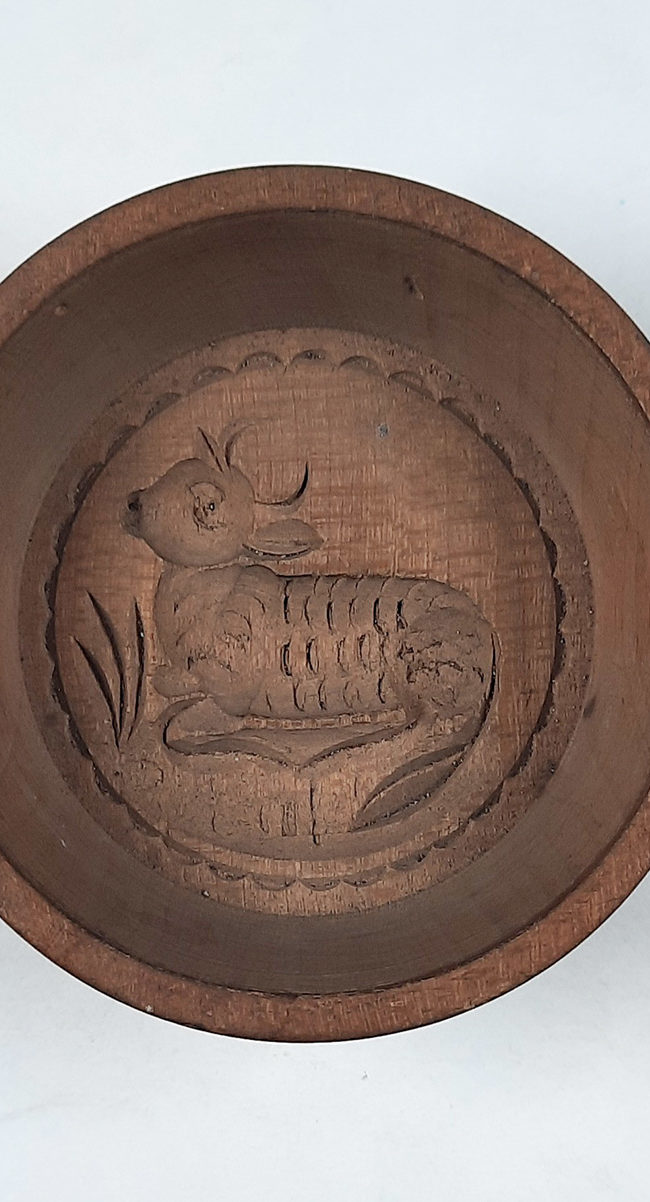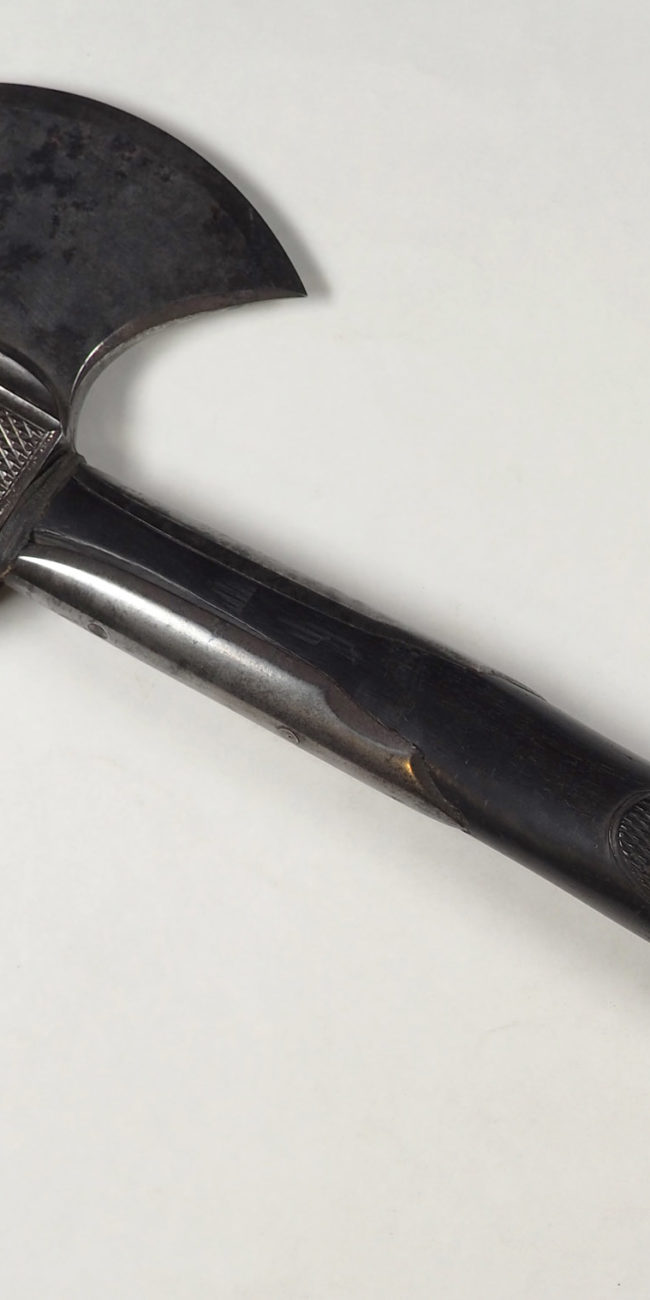
The unusual objects No. 9

Bon Air Garden City and the rise of socialism in Belgium
While the Beguinage is being reorganised, Erasmus House is putting an unusual objects from the municipal museums’ vast historical, archaeological, folk art and religious collections on display each month. This month the museum is exhibiting the presentation trowel of Bon Air Garden City, which will soon be celebrating the centennial of its founding. This housing estate recently underwent renovations designed to restore its original style.
Ceremonial trowel used by King Albert I to lay the first stone of Bon Air Garden City and etched with the inscription: “Cette truelle a servi le 15 avril 1923 à Sa Majesté Albert 1er pour la pose de la première pierre de la Cité-jardin “Bon Air” construite par le Foyer Anderlechtois”. (“This trowel was used by His Majesty Albert I on 15 April 1923 to lay the first stone of ‘Bon Air’ Garden City built by [the housing society] Foyer Anderlechtois”)
Belgium
Wood, wrought iron
1923
35 x 15,5 x 15 cm
Inv. BEG 5429
Anderlecht boasts three garden cities built on its territory between the wars, namely, Moortebeek, La Roue and Bon Air. They were designed to meet the expectations of the hygienist movement that was initiated by doctors and chemists who were working on methods to protect and improve public health at the time. The common aim of these developments, according to the Belgian post-war reconstruction theoretician Louis Van der Swaelen, was “to house all men in a way that was worthy of human beings”. This month Erasmus House Museum presents the trowel that was used to lay the first stone of the Bon Air housing estate.
The history of garden cities
The early 19th century was a period of industrial growth that generated a huge influx of people seeking work in town. The manufacturers of the time built workers’ quarters in order to house their workforces less expensively. The best workers were rewarded by being given larger, better ventilated houses, whilst the others had to make do with lodgings that were overcrowded and not fit for habitation. These blue-collar quarters, which were built on the towns’ outskirts, triggered worry in the ruling class. The most affluent feared that epidemics would spring up in these neighbourhoods and social uprisings would follow. Working class poverty was also a matter of concern, for it spawned begging and crime. A survey of Brussels housing conducted by the journalist Édouard Ducpétiaux in 1838 revealed the unhealthy conditions that reigned at the time, inciting the country’s leaders to adopt various laws to correct them. Some of them, such as the Belgian politician Hector Denis, tried to create decentralised companies that would enable the public authorities to work in the building sector without depending on private capital. However, not until war and the destruction of countless homes that it brought would new, better equipped neighbourhoods emerge.
The blueprints for Bon Air, like those for other garden cities, were drawn in the wake of World War I, although the concept of these “green” housing estates was proposed by Belgian members of the social hygiene movement as a solution for worker housing as of 1880.
The Bon Air Garden City ceremonial trowel
A ceremonial trowel (the silver or presentation trowels of UK history) is a relatively rare object. The Belgian heritage inventories drawn up by the Royal Institute of Artistic Heritage (IRPA) identify only a dozen of them in Belgium dating from 1600 to 1950. These trowels were used only once, that is, to build an administrative building such as the Town Hall of Saint-Gilles, the Congress Column, or the Brussels Royal Warehouse. The secular States borrowed this celebration from the Catholic Church, which consecrates the laying of the first stone of an edifice in a special ceremony.
This housing estate was christened “Bon Air” (Good Air) because it exuded health and cleanliness. In the same vein, the streets that bordered it were called Hygiene Street, Healthiness Street, and even Fertility Street, and surrounded by a green belt. This estate was built to house the residents of Brussels’s blue-collar neighbourhoods, which were barely fit for habitation, and the Marolles in the run-up to major town-planning works of Haussmannian inspiration. The single-family houses all had small front gardens and the estate was built in three phases spread out between 1930 and 1953.
The dwellings belong to the municipal social housing society Foyer Anderlechtois, which also owns La Roue. The latter looks more like a blue-collar development, whereas Bon Air is more the incarnation of a middle-class garden city. The project architect was Hermann Voets, brother of the sculptor Victor Voets, who also worked on the plans for La Roue. That explains the similarities between the two neighbourhoods. On 15 April 1923, King Albert I laid the first cornerstone of Bon Air Garden City using the trowel displayed here and which bears the following text:
« Cette truelle a servi le 15 avril 1923 à Sa Majesté Albert Ier pour la pose de la première pierre de la Cité-jardin “Bon Air” construite par le Foyer Anderlechtois »
[“This trowel was used by His Majesty Albert I on 15 April 1923 to lay the first stone of ‘Bon Air’ Garden City built by [the housing society] Foyer Anderlechtois”]
This presentation trowel is more than a simple honorific object; it symbolises the rebirth of a war-ravaged country in which social actions were being taken to improve the Belgians’ well-being.
Read the full brochure about the Bon Air Garden City ceremonial trowel
Practical information about your visit
Research and text
Meggy Chaidron
Acknowledgements
Zahava Seewald
Céline Bultreys
Anne Deckers







